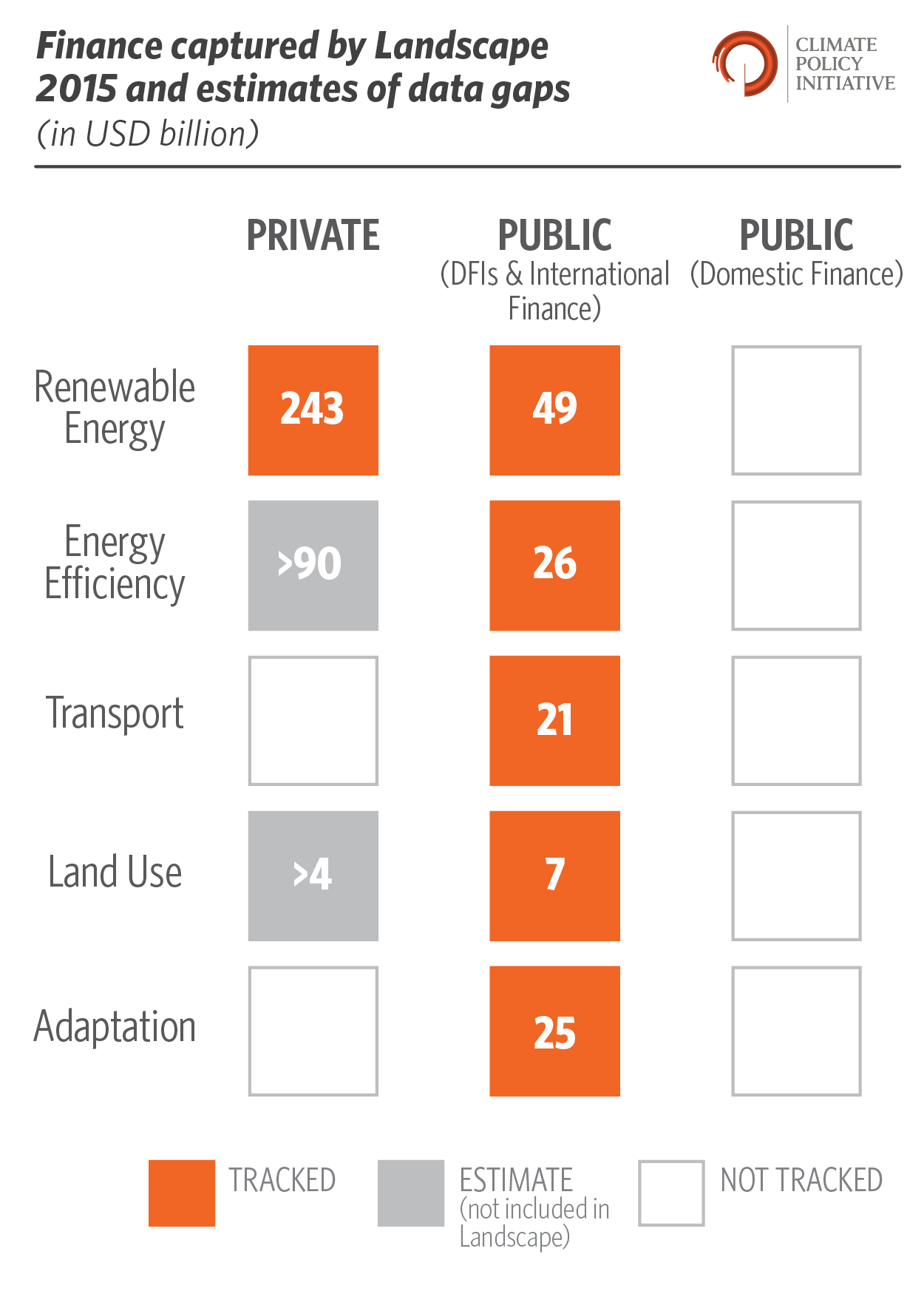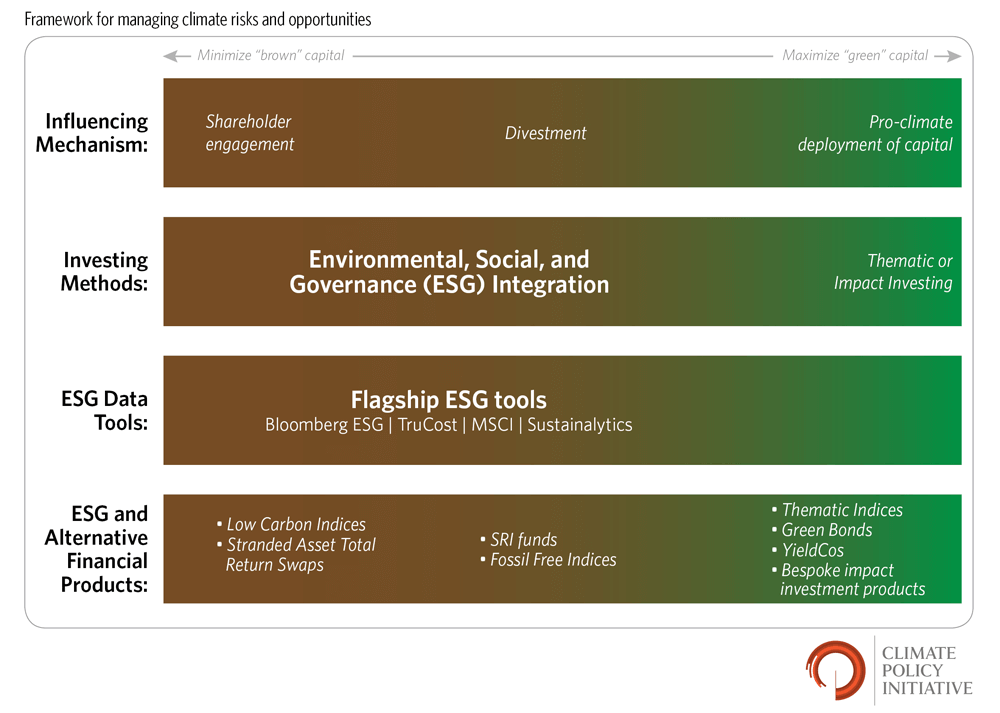As part of efforts to limit the increase in the global average temperature to well below 2°C, the Paris Agreement states that countries participating in the international climate negotiations shall make ‘finance flows consistent with a pathway towards low greenhouse gas emissions and climate-resilient development’.
CPI’s Global Landscape of Climate Finance and San Giorgio Group Case Studies have highlighted the important role of public resources and policies in influencing growth pathways. However, while data collection at the international level has improved in recent years (for example through the OECD DAC system), many governments and public organizations still lack a comprehensive system to track and report domestic climate-related expenditures and international climate finance.
In terms of collecting and publically reporting information about its climate finance investments, the private sector lags even further behind.

This is problematic for governments and investors alike. Exposure to climate risks will have widespread effects on the value of assets and therefore, the ability of pension funds and insurance companies to pay out to their beneficiaries. Costs of compliance with standards or policies, risks of stranded assets, changing agricultural and commodity prices, increased scarcity of essential resources like water, disruptions in business supply chains, and damage to infrastructure and other assets will all impact companies’ and investors’ financial performance, as well as countries’ economic growth.
Investors are gaining more clarity on the exposure of their financial assets to climate change risk through companies’ increasing disclosure of environmental, social, and governance (ESG) data. To date, demand for companies to disclose the climate risks they face has mainly been driven by disclosure initiatives and pressure from investors, with mandates from financial regulators and exchanges increasing in importance.
However, as CPI analysis has shown, there is little consistency in the quality and scope of information disclosed. Definitions are applied in different ways and many metrics are preliminary. Last December, the Sustainability Accounting Standards Board (SASB) reported that 93% of listed U.S. companies face some degree of climate risk but only 12% have disclosed it.
The challenge in the medium-term is to harmonize and improve definitions and metrics to provide investors and policymakers with comparable and reliable data with which to compare performance and formulate investment policies. Forthcoming recommendations on how to standardise such disclosures from the Taskforce on Climate-Related Financial Disclosures are due in December could provide some guidance. In the short-term, increased transparency is a good start.
Green bonds provide a case in point. Concerns about where finance raised from these bonds goes have led a number of different organizations to develop different assurance solutions. However, recent trends show issuers may be choosing transparency as the least cost option.
In 2015, 72% of green bond market by value sought an independent review. In the third quarter of this year, less than half did so, with issuers themselves opting instead to disclose how the proceeds of bonds will be used, and their process for selecting green projects.
Investors in the market seem broadly satisfied with this for now but this could change.
French investors now face their own for disclosure requirements both on how they are managing climate risk and how they are contributing to “energy and ecological transitions.” A French law, the first to introduce mandatory carbon reporting by investors, requires investors with a balance sheet of €500 million or more to submit their first reports on how they are approaching these issues by June 2017.
What remains less clear is whether such disclosure will provide enough comparable and reliable detail on the kind, location and performance of assets (e.g. in terms of emissions reductions, increased energy productivity, or increased resilience to adverse weather conditions) to provide more comprehensive overviews of how finance is accommodating climate change impacts and opportunities.
While some questions remain, increased transparency will certainly support investors and regulators’ efforts to mainstream ESG investment, and to move from understanding to managing climate risk, thus optimizing climate-related investment opportunities.
Increased transparency will also open new opportunities for financial product and service providers to refine existing and create new green investment products that reduce capital costs for the organizations driving energy and land use transitions.
Greater clarity on public and private finance flowing to climate-relevant sectors where little reliable information is currently available can also improve policymakers’ understanding of how public and private interests and capabilities interact, enabling them to refine support frameworks to ensure effective spending and to maximise the economic benefits of transitions in energy and land use.
CPI remains committed to supporting investors to improve their understanding of climate risks and highlighting how to make the most of the opportunities presented by countries’ transitions to low-carbon and climate-resilient economies.
Since 2010, CPI has supported decision makers from the public and private sectors, at international, national and local levels, to define and track how climate finance is flowing from sources and actors, through a range of financial instruments, to recipients and end uses. Providing decision makers with robust and comprehensive information helps them to assess progress against real investment goals and needs. It also improves understanding of how public policy, finance and support interact with, and drive climate-relevant investment from diverse private actors, and where opportunities exist to achieve greater scale and impact.
This blog is part of a series on climate finance tracking challenges. Read more here.
Sign up for updates to stay informed on this and other aspects of our work.
Get in touch with CPI’s lead analyst working on private capital markets.


